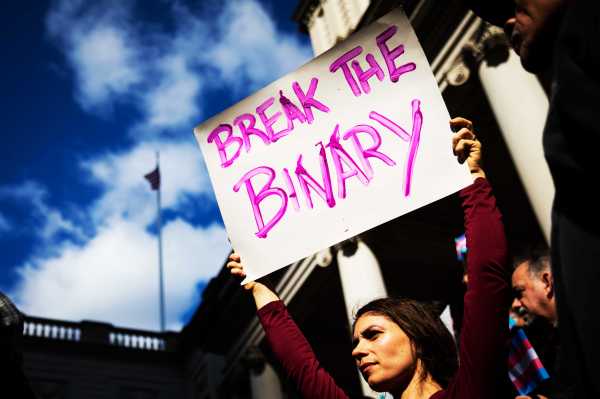
The internet made trans people visible. It also left them more vulnerable.
This decade has been a double-edged sword for trans people.
By
Katelyn Burns
Dec 27, 2019, 8:00am EST
Share this story
-
Share this on Facebook
-
Share this on Twitter
-
Share
All sharing options
Share
All sharing options for:
The internet made trans people visible. It also left them more vulnerable.
-
Reddit
-
Pocket
-
Flipboard
-
Email
Part of
Looking back at the tumultuous 2010s
In 2010, the US had its first Black president, Facebook hadn’t yet gone public, and people still thought I was a man.
The way I experienced these past 10 years as a trans woman almost mirrors the status of the trans community at large. I entered the decade ostensibly as a happily married man, trying to build my life and career while repressing my gender identity. Five years in, I found my true self through persistent self-exploration. And I’m now leaving the decade scared shitless.
Few marginalized communities have experienced such dramatic whiplash of fortunes over the course of the 2010s as trans people. Where once the public only had access to trans stories through traditional media coverage (that was rarely flattering), we exit the decade with trans people starring in regular roles on television and in film, and transgender journalists beginning to break through into the traditionally cisgender-controlled media apparatus.
This year, 24 percent of Americans reported having a close friend or family member who is transgender, according to a Public Religion Research Institute poll — that’s more than double the 11 percent who reported knowing a trans person in 2011.
Visibility has had an impact on our rights as well. In 2010, only trans people who could afford expensive surgery were able to legally change genders, and often the cisgender men who controlled psychology dictated that trans women must be attracted to men only in order to medically transition. Nonbinary people, meanwhile, were seldom given a thought even by some trans people. Now, just nine states require surgery in order to change gender marker on state IDs, while 13 states plus the District of Columbia allow nonbinary gender markers on IDs. The singular “they” was named 2019’s word of the year by Merriam-Webster.
We didn’t arrive at this moment overnight, though. The story of how we got to a point where centuries-old conceptions of gender are now being regularly challenged in popular culture begins and ends with the thing that we love to hate: the internet.
While the early internet of the 2000s established a way for trans people to connect with each other quickly and over long distances, the second wave of web progress — social media and YouTube — has helped trans people leverage visibility into substantial policy gains. But with that progress also came a conservative backlash and campaigns to discredit our basic human rights. The internet, and trans visibility at large, has devolved into a double-edged sword for the trans community. It’s a dynamic I am all too familiar with.
How we arrived at trans visibility
I don’t remember the name of the first trans person I ever knowingly met. But around 2011, I was working at a bank when a customer informed me that his daughter would be helping with his finances. He also warned me that his daughter was a little different.
“When my late wife was pregnant, we were in a car crash,” he explained. “So when my daughter was born, we thought she was a boy, but it turns out she wasn’t.” It was a sweet if inaccurate attempt at explaining his daughter’s gender identity.
The first time I met his daughter, I remember registering her trans identity. I had already been secretly reading any trans-related news I could dig up but was still feeling like an outsider to the language of the community. Despite having a million questions for her (that were really about myself), I didn’t say anything.
Over the course of increasingly frequent interactions, she never talked about her trans status, but I learned more about the rest of her life: She was a pilot and owned her own single-engine plane, flying into Maine from out of state on frequent visits to care for her aging father. She was the first trans person I had ever encountered outside of sensationalized Hollywood portrayals of deranged trans women. At the beginning of the decade, media attention was limited to the exploitative Jerry Springer episode or deceptive villain role in a movie. Trans people likely only existed in the back of the average cis person’s mind.
And then one day she opened up and thanked me for making her feel like a normal human. She said that she didn’t trust anyone else to help her at the bank because many had been dismissive of judgmental. It was a moment I’ll never forget — because it also started a long thaw of repression I had maintained for my own gender feelings. And yet, it would take several more years to work out whether and how to transition.
These years of questioning and exploration aligned with a series of high-profile trans people coming out. It was also when public consciousness on trans people and out issues starting to shift.

Chelsea Manning came out as a trans woman on the eve of her sentencing hearing in 2013, accompanied by a grainy black and white photo of her in a blond wig. While discussion of her crimes was highly politicized, for many Americans, Manning was the first trans person to receive wall-to-wall coverage in the 24/7 cable news cycle.
Then came Time Magazine’s “Transgender Tipping Point” cover featuring Laverne Cox in 2014. The magazine declared that the transgender moment had arrived, presenting trans rights as the next great civil rights struggle. Even after the “tipping point,” though, journalists and media still struggled with how to talk about trans lives and experiences.
“Anytime a transgender person would speak about their experiences in a talk show or a journalistic setting [before 2014], people felt that it was perfectly appropriate to ask detailed questions about our genitals, our bodies, our sex lives, surgeries that we’ve had, up to asking is whether or not we have orgasms. It was just the way things were,” Tyler Adams, director of transgender representation at the LGBTQ media advocacy organization GLAAD, told Vox.
That media dynamic only began to shift after another pivotal Cox moment. In a 2014 interview, Katie Couric asked trans model and actress Carmen Carrera invasive questions about her genitalia and her transition. Couric’s next guest was Cox, who pointed out how Couric had been out of line. According to Adams, Cox was one of the first trans people to immediately push back on an interviewer’s inappropriate questions.
But that moment would be topped by the most public transition thus far: In 2015, Caitlyn Jenner appeared on a glamorous Vanity Fair cover. By the end of that year, most Americans were finally at least aware of the existence of a trans person.
The internet boosted trans visibility. At first, there were many positives.
In the background of all these high-profile transitions, a decade and a half of digital organizing had already been taking place, positioning the trans community for its moment in the sun. Since the trans community is relatively small, roughly only 0.6 percent of adults in the US, traditional local organizing was next to impossible outside of large cities like New York or San Francisco. For trans people, the internet became a critical revolutionary tool.
In the early 2010s, I was still closeted, with a wife and children. I didn’t access the local trans community where I lived in Maine, and I mainly used my Twitter account to follow soccer news. But around the middle of the decade, I first realized that I might need to transition and started following a handful of trans people.
Seeing them discuss topics that I was interested in, alongside trans issues or their personal transitions, was how I eased into accepting my own trans identity. Eventually, I started my own anonymous trans account, which initially was meant to document the tragicomedy of being a closeted trans woman, but it quickly became a place to take baby steps into expressing my authentic identity without suddenly jumping into real world situations.
“[The internet] was a game-changer as far as I’m concerned,” trans writer and activist Monica Roberts told Vox. “Unlike the ’90s, we now have real-time communication links where we can not only talk to each other nationally, but internationally and in an inexpensive way.”
According to Roberts, the early internet not only helped trans people organize politically, but also gave trans people access to transition resources and language to describe their gender identity on a massive scale. Starting with the rise of blogs in the early 2000s, trans people created internet spaces and conversations for their own survival. Roberts’s own blog, TransGriot, has been one of the most important sources of trans news, analysis, and activism over the course of the decade.
While trans people were discovering themselves and self-advocating over the web, the internet itself was going through a huge overhaul by 2010. The rise of YouTube and Tumblr allowed trans people to become content creators on their own, cutting out the cis media gatekeepers that long held sway over how trans people were perceived within society. Adams told Vox that trans young people have been “able to go onto YouTube and develop these really strong relationships with trans content creators who talk about their transitions, because they’re interactive in a way that mainstream media is not.”
While relatively well-known YouTubers like Gigi Gorgeous or ContraPoints announced their transitions on their channels, other smaller content creators on the medium centered their trans experiences. YouTubers like Kat Blaque, a Black trans woman, struck an interesting balance between speaking to trans issues on their channels while also offering a broader assortment of content.
For me, it was a steady mix of YouTube, Reddit, and other internet forums that eased my transition-related anxiety. One result of anti-trans propaganda is that, even for trans people, it’s hard to trust that treatments like surgery or hormones will produce the results you want. Seeing before and after photos on transition timelines of other trans people helped me conceptualize how hormone replacement therapy would work on my own body and appearance, and I eventually took the plunge.
But it wasn’t just trans people watching trans content creators — cis people were paying attention as well. According to Adams, some of the most valuable trans educators on YouTube became those who had appeal in other areas besides leading a trans life.
“People who aren’t able to get into a writers room in Hollywood, or who are not journalists, can create a cool platform on social media that extends out past the trans community and [appeal to] other people who don’t know someone who’s transgender in their life,” Adams said. Those cisgender people “are able to learn something about us because they follow someone on social media who has a smart and intelligent voice — that is a way in which I think social media can help change public attitudes about transgender people.”
Along with changing public attitudes and more awareness came initial gains in trans rights. First and perhaps most importantly, trans people in the US gained the ability to change their gender on their passports without surgery in 2010. In a time when most states still required surgery for trans people to have identification matching their lived gender, loosening the passport requirement allowed thousands of people to have accurate government ID to be able to apply for jobs and housing, cross borders, vote, and even buy alcohol without outing themselves as trans to perfect strangers.
Then in 2014, President Barack Obama’s Affordable Care Act barred insurance companies from excluding people with preexisting conditions — among them people with gender dysphoria. Before that, trans people with a gender dysphoria diagnosis often couldn’t access health insurance at all.
The Obama administration also barred insurance companies from making blanket exclusions on trans-related health care, opening the door for thousands of trans people to medically transition who couldn’t previously afford it. It also pressed for more trans-friendly school and anti-bullying regulations, and sought to create a safer prison environment for incarcerated trans people.
Thanks to Obama, and the sudden societal shift towards trans acceptance, I believed I would be transitioning into a more tolerant world than the one tread by my trans predecessors. The internet had been crucial in paving the way for easier trans lives through social change and policy reforms. But a new threat was looming in the background, and it was also feeding off the internet beast.
Midway through the 2010s came the serious backlash to trans visibility
After the Supreme Court ruled in 2015 that same-sex couples could legally marry, the religious right seemed poised to lose the so-called “culture wars.” The biggest LGBTQ fight in legislatures and courts until then had resulted in a devastating loss for religious and cultural conservatives. But instead of packing up and going home, the far right simply shifted their focus to a new, more vulnerable group — trans people.
That effort kicked off in earnest in 2015, mere months after Caitlyn Jenner’s Vanity Fair cover and the Supreme Court’s landmark Obergefell ruling, in a Houston referendum over the city’s LGBTQ nondiscrimination ordinance. Focusing on the law’s public accommodation protections allowing trans people to use bathrooms according to their lived gender, conservatives seized upon a narrative that trans women are really just creepy men who didn’t belong in women’s restrooms. “No men in women’s bathrooms” became the latest right-wing rallying cry as conservatives melted down over the prospect of a society that might become slightly easier for trans people to live in.

“There is an inevitable backlash against progress,” said Roberts, who lives in Houston and saw the referendum battle in person. “The conservative movement has this major feature — they always have to have an enemy to organize around.”
Though one prominent conservative would later admit that the bathroom predator narrative was based on a total myth, the Houston campaign became an early turning point in the political battle over trans rights. The following year would see North Carolina enact its now-infamous “bathroom bill” requiring trans people to use the restroom denoted by their original birth certificate in all publicly owned buildings, which included schools. Through it all, the internet was a powerful messaging and recruiting tool for the anti-trans activist movement.
It also had the desired effect of making trans people second guess whether to appear in public spaces. Around the time of North Carolina’s bathroom bill, I went to the local mall wearing a little makeup, a horrid wig, and a women’s top and jeans. I was a nervous wreck.
Due to a design quirk, the door for the family restroom was inside the women’s room. I walked inside and tried to quickly jerk the door open, but it didn’t budge. The noise drew the attention of about a half-dozen women washing their hands. My face flushed with embarrassment and fear. One mom, who was there with her little girl, chuckled and told me the same thing had just happened to her moments earlier. I half-smiled in response, not daring to use my voice while quickly sliding into a stall to do my business. Even though that woman was kind to me, growing anti-trans sentiment had put me on edge.
According to Brennan Suen, who analyzes LGBTQ media coverage for Media Matters, fear is the key factor that makes trans content go viral on social media. Where once fear of trans progress was based in part on the bathroom predator myth, it has since evolved to worries of people about trans athletes taking away athletic opportunities or trans people trying to recruit and “trans” children with irreversible medical procedures.
Trans people have “become so visible in the last 10 years, even though the community has always existed,” Suen told Vox. “It feels new to people, even if it’s not, and that is an area that is fruitful for the right to take advantage of — because when you don’t understand something and it seems strange or a little bit scary and then you’re being fed more information that is scary,” you tend to believe it.
The existence of trans people presents a fundamental threat to the gender hierarchy pushed by cultural and religious conservatives. Many Christian fundamentalists envision a particular family structure where God looks over the patriarch of the family, who is responsible for protecting and providing for his wife and kids. The mother of the family is responsible for managing the home and producing Christian children, while children must be obedient to their parents.
Raised by lenient Catholics, I too went along with gendered expectations into adulthood, mainly because I just thought that’s what a person was supposed to do. I waited to meet the love of my life to have sex. We got married, we had kids, we bought a house and moved to the suburbs. By all outside accounts, I had a good, normal life. But it didn’t feel like my life to me. The bright moments were dulled, as if felt by another person entirely.
Then I started to explore my identity. Eventually, I told my wife everything — my dysphoria as a child, how I had locked away my female side when she asked me to at age 18, how I had tried to take my own life.
I remember she and I holding each other as it became clear that things were ending. She kept asking me why. Why did I have to do this? Why did I have to do this to her? And the truth is, I never really had an answer that made sense. Nonetheless, I knew it was something I had to do for my own survival. I hit a point where I couldn’t spend another day as “him.” It physically hurt to go on. So I let him go.
Giving up my gendered spot in society has come with difficult repercussions. The little house on a hill in Maine is gone; my ex-wife and kids are no longer in my daily life. I live in a city again, by myself. It’s hard, but at least I can feel again. The good moments are sweeter, and the bad moments are sharper.
Cultural sexism — ingrained in all of us on some level — has been at the core of the conservative backlash against trans rights over the last half-decade, so it didn’t take long for far-right conservative groups to quickly spring into action to drive social fear of trans progress. In 2015, the Family Research Council developed a document that spelled out how religious conservatives should respond to the trans rights movement — and then it found its most critical partner the following year.
The election of Donald Trump was a key turning point in the conservative war on trans rights. He helped put FRC’s anti-trans plan immediately into motion; a month into office, he rolled back Obama-era guidance aimed at protecting the educational experience of trans students. Since then, the Trump administration has engaged in a widespread campaign across virtually every federal government agency to repeal or outright erase trans rights and people from government documents.
Among the administration’s efforts: banning trans troops from serving in the military, petitioning the Supreme Court to roll back employment protections under Title VII, proposing a rule to undo Affordable Care Act nondiscrimination protections for trans patients, allowing federally funded shelters to bar trans people from homeless shelters consistent with their gender identity, and requiring prisons to house trans prisoners according to their assigned sex at birth.
By the tail end of the decade, the culture war was successfully killing trans rights, and the targets were both sweeping and personal.
The far-right crusade against trans people rages on
Behind the conservative backlash is a vast right-wing network of media, social media, and online gathering places for anti-trans activists, all devoted to spreading misinformation. Far-right website Breitbart regularly puts out headlines out like “Transgender: Prediction of Malpractice Lawsuits for ‘Gender-Affirming’ Doctors.” Meanwhile, forums like Mumsnet, which began as a community message board for British mums, have become havens for transphobic comments and harassment. Other conservative outlets and anti-trans web forums try to push false information about trans-affirming medical practices under a veneer of “reasonable concerns.”
Online harassment is particularly concentrated on trans people through social media. Any trans person who receives public attention, even for non-trans related news items, is likely to face a torrent of online abuse in return. And it’s often organized behind the scenes through various anti-trans web forums and Facebook groups.
Early on in my journalism career, pretransition pictures of myself with my young children were posted and mocked on the “GenderCritical” subreddit, a gathering place for self-proclaimed feminists who oppose trans rights. I’ve since been doxed on other online forums and face a near-daily drumbeat of transphobic comments on my Twitter account. I’ve come to accept this as the necessary cost for being a trans journalist who covers trans issues.
Media Matters’s Suen said the rise of online anti-trans sentiment can be traced to the merging of the US right wing with British anti-trans feminists, which have formed an alliance to specifically target trans people with online harassment and misinformation. One particularly pernicious theory that’s been latched onto by those opposing trans rights is the concept of “rapid-onset gender dysphoria.” In 2018, Brown University researcher Lisa Littman published a survey of parents purporting to investigate transness in adolescents as being caused by social contagion.
The theory, in essence, claims that young people are being incorrectly convinced that they are trans through reading Tumblr blogs or watching YouTube videos about being trans. While Littman never spoke to trans children themselves to form her theory, she concludes that there may be a new type of gender dysphoria being spread through social media and peer pressure. Her study has since been heavily revised following critique from trans people and the wider scientific community.
Ironically, it’s trans visibility that forms the basis for the theory of “rapid-onset gender dysphoria.” According to Suen, Littman correctly cites evidence of growing numbers of trans adolescents presenting at gender clinics as evidence of a possible new type of gender dysphoria diagnosis. But it’s likely Littman is really just seeing the inevitable result of a commensurate growth in trans youth visibility — children more comfortable to express their gender identity because of trans YouTube creators and reality shows like I Am Jazz, about the life of young trans girl Jazz Jennings, who transitioned at age 5.
Despite relatively little scientific and academic grounding, “rapid-onset gender dysphoria” has become part of a full-fledged media narrative, especially within right-wing and British media. Over the past few years, the theory has been discussed deeply in the pages of the Wall Street Journal, the Times of London, and many other far-right blogs in part because numerous online anti-trans spaces have popped up in recent years to push conspiracy theories about the trans community and trans health care.

According to Suen, it’s up to the media to pushback on anti-trans disinformation campaigns in a more substantial way than they are currently. “Mainstream media has a responsibility to not just treat [trans people] with dignity, but to give accurate information,” he said. “The big issue here is that the conversation on the right is extremely loud and it is very often factually incorrect… There’s a true public health crisis that can arise from allowing the right to dominate the conversation.”
Though the financial state of media, and specifically LGBTQ media, is currently fairly grim, there has been a substantial change in the way mainstream media has covered trans issues. Katie Couric’s 2014 interview with Carmen Carrera and Laverne Cox came just months after the publication of “Dr. V’s Magical Putter,” by now-defunct sports outlet Grantland, in which a cisgender male journalist investigated the creator of an allegedly high-tech putter, and then discovered that its creator, Essay Anne Vanderbilt, was a trans woman.
Rather than pausing to consider the implications of revealing that information to the public, the writer and editors pressed on, and Vanderbilt herself ended up taking her own life just weeks before the story was published. Grantland ran it anyway, not putting it together that their reporting probably contributed to the woman’s death. An overwhelming backlash from the trans community made a lot of high-level editors realize that they needed more trans perspectives in their work.
My own writing career started shortly into 2016, and I was definitely a beneficiary of a media industry looking for more trans voices. What started with self-published essays about my own transition turned into reported pieces tied to trans news like North Carolina’s bathroom bills. From there, I challenged myself to do more and more complex reporting about the gains in rights we experienced in Obama’s final year, followed by the sudden impact of Trump’s anti-trans agenda.
The past several years have felt a bit like those first few years after graduating college: I’m learning how to adult in a new gender, in a new career, and doing it all in a new city. I find myself at peace with the life I’ve left behind to live the life I needed to live. I am filled with equal parts hope and trepidation for the next chapter.
As trans people enter the new decade, many of us also find ourselves and our rights on knife’s edge. Trans issues have hit the Supreme Court for the first time, with a case that could determine trans employment rights for a generation. Then there is the 2020 election, which could determine whether our rights will be further eroded or finally protected.
In the meantime, the internet is now the battleground on which we fight — against hate, against intolerance, against disinformation. But mostly, we fight for the right to exist in our own bodies. In the past decade, we have proven we are capable of taking a political punch and remaining on our feet. The trans community is stronger than we know.
Sourse: vox.com






